
What's tuna? → Species
Species of Tunas
Classification
What we commonly refer to as tuna are the eight species of fish in the genus Thunnus.
This genus Thunnus also includes mackerel (saba) and bonito (katsuo). It is interesting to think that tuna, which can grow up to three meters in length when large, is a member of the same family as mackerel, which is popularly known for its salted and grilled fish.
Species of Tuna
Pacific Bluefin Tuna
Thunnus orientalis
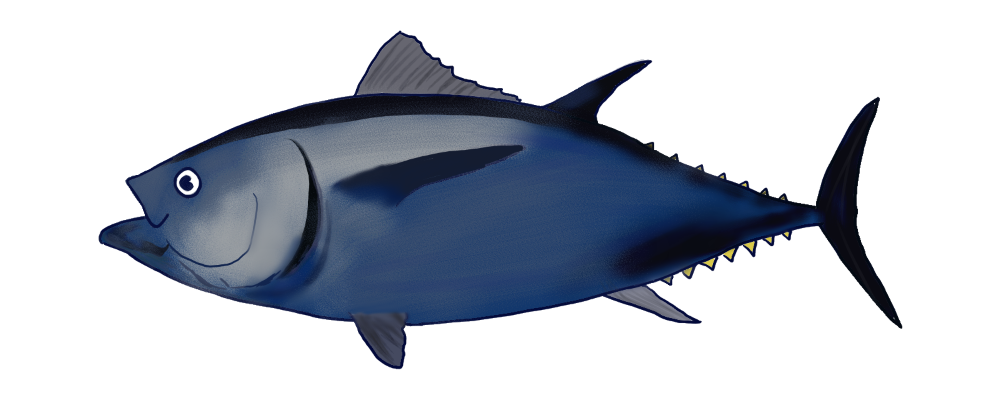 |
This is the most major tuna species found in the Pacific Ocean. It is said to have the best taste of all tuna, and is sometimes referred to as the best tuna among tuna. Basically, it is bought and sold as sashimi and sushi. It is characterized by its huge size (up to 3 m in length), blue-black back, small eyes, and short pectoral fins.
|
Atlantic Bluefin Tuna
Thunnus thynnus
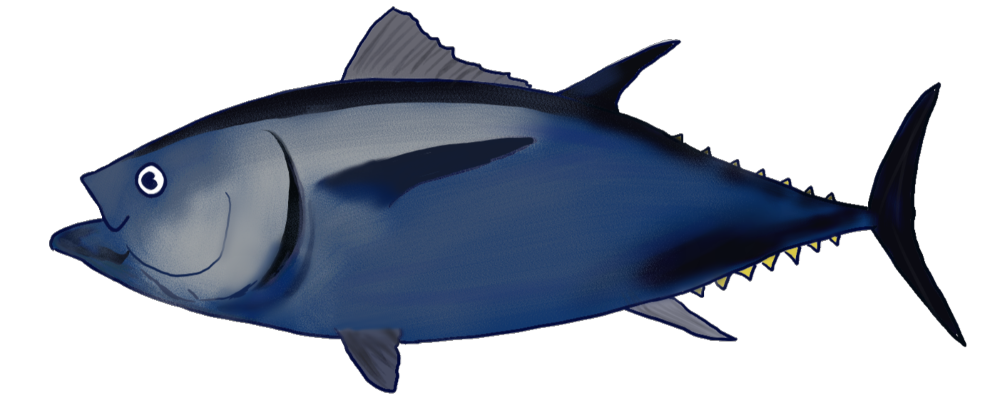 |
A subspecies of bluefin tuna that lives in the Atlantic Ocean. Like bluefin tuna, it is used for sashimi and sushi, and like bluefin tuna, it is highly valued as a luxury item because of its large amount of fatty tuna. The differences from bluefin tuna are habitat, longevity, and body size. Pacific bluefin tuna has a slightly longer life span than bluefin tuna, and its body is larger than that of bluefin tuna. Its color and other characteristics are the same as those of the bluefin tuna.
|
Southern Bluefin Tuna
Thunnus maccoyii
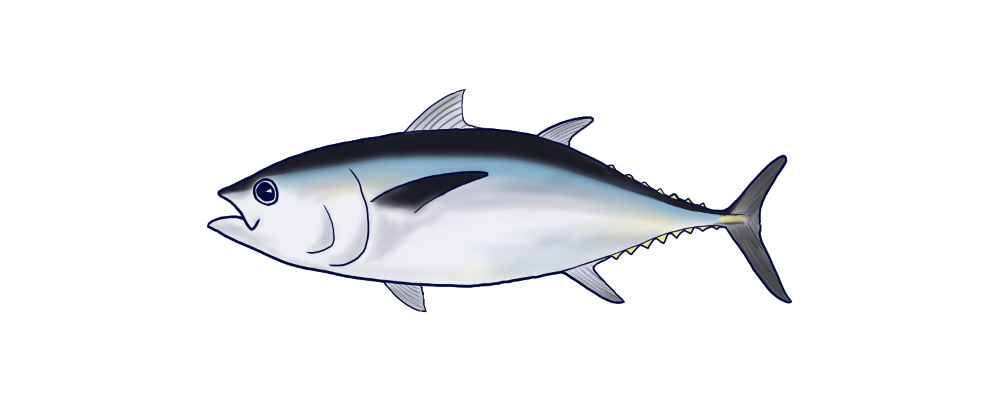 |
This species lives in the southern hemisphere oceans, mainly in the cold waters between 50 and 30 degrees south latitude. Like bluefin tuna and Pacific bluefin tuna, it is a high-end product in the market because of its high fat content. Like the two species above, it is used for sashimi and sushi. It is sometimes called Indian tuna because it was produced in the Indian Ocean in the early days, or Australian tuna because many Australian tuna is imported. It is characterized by its smaller size than the above two types.
It is also listed as endangered on the Red List.
|
Bigeye Tuna
Thunnus obesus
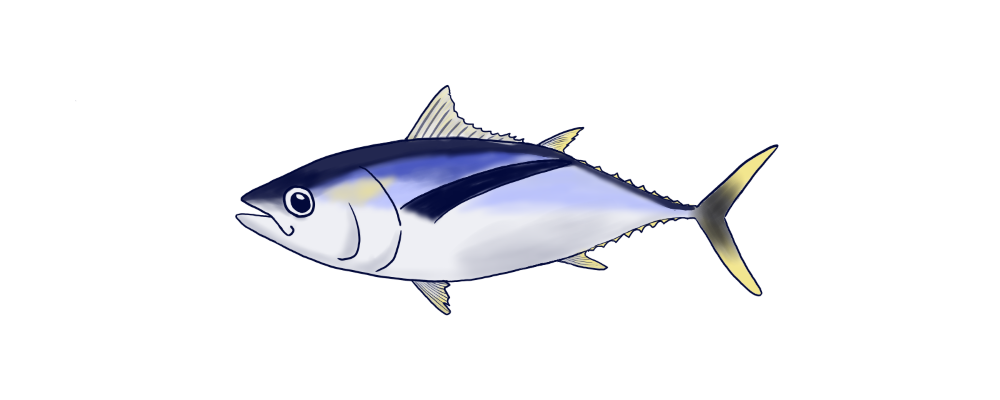 |
Found in temperate and tropical zones around the world. Although less expensive than bluefin tuna, the red meat of bigeye caught in the seas around Japan from early spring to late summer is said to be almost as good as that of bluefin tuna, making it the most widely consumed tuna in Japan. Its uses are as sashimi and sushi, while juvenile fish are used as canned fish as they are not suitable for sashimi. It is characterized by its large eyes.
|
Albacore Tuna
Thunnus alalunga
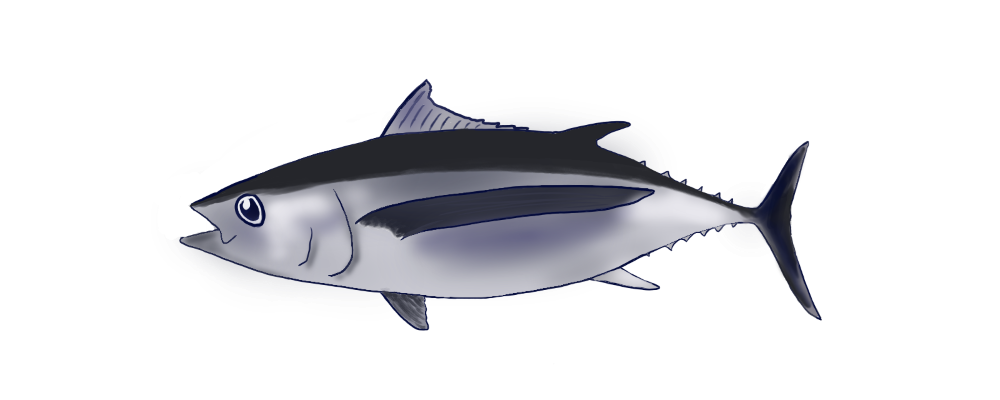 |
Albacore tuna can be found in warm waters all over the world. It is called albacore because its pectoral fins look like long sideburns. Compared to bluefin tuna and other species, albacore has a pale pink flesh color and is not very expensive as sashimi. However, its fatty flesh is popular at conveyor-belt sushi restaurants. Its basic use is for canning, and it is the highest quality canned tuna. It is characterized by its long pectoral fins.
|
Yellowfin Tuna
Thunnus alalunga
This is widely found in the tropical and temperate zones of the world. Because it lives in shallower waters than bigeye tuna, its flesh is lighter and less fatty, and it is sold at a lower price. It is widely used for sashimi, teriyaki, and canned. It is widely used in the Kansai region for sashimi and sushi. It is characterized by its yellowish tail fin, dorsal fin, and body color.
Blackfin Tuna
Thunnus atlanticus
This inhabits the western side of the Atlantic Ocean. It used to be called Taisei Bluefin Tuna, but to avoid confusion with Taisei Bluefin Tuna, which is a subspecies of Bluefin Tuna, it is now called Blackfin Tuna. It is rarely eaten raw and is often served canned or otherwise processed. It is characterized by its black fins.
Longtail Tuna
Thunnus tonggol
This species lives on the continental shelf from the Indian Ocean to the Atlantic Ocean. It is used for canning, steaks, and other processed products. It is characterized by its long tail, being the only member of the tuna genus that does not have a floating bag, and its relatively small size (about 1 m in length).

|
There are eight types of fish commonly called tuna, each with different characteristics and food uses.
Through my research, I was also surprised to learn that tuna and swordfish are also in different taxonomic families.
|
Tuna Quiz (1)
Which one is tuna's relative?
Salmon
Incorrect!
Salmon is a fish in the family Salmonidae, the order Salmonidae. Rainbow trout and char are members of the same family.
Bonito
Correct!
Bonito, like mackerel, is a member of the mackerel family of the sea bass order.
Shark
Incorrect!
Sharks are cartilaginous fish in the cartilaginous fishnet and are distantly related to the hard-bone fish orders tuna (Macaca fascicularis) and salmon (Salmoidea: Salmonidae).
 Home
© 2022-2023 マグロの学校/School-of-Tuna All rights reserved.
Home
© 2022-2023 マグロの学校/School-of-Tuna All rights reserved.
![]()
![]()
![]()
![]()
![]()
![]()
![]()
![]()
![]()
![]()
![]()
![]()
![]()
![]()
![]()
![]()
![]()
![]()
![]()
![]()
![]()
![]()
![]()
![]()
![]()
![]()
![]()
![]()
![]()
![]()
![]()
![]()
![]()
![]()
![]()
![]()
![]()
![]()
![]()
![]()
![]()
![]()
![]()
![]()
![]()
![]()
![]()
![]()
![]()
![]()
![]()
![]()
![]()
![]()
![]()
![]()
![]()
![]()
![]()
![]()
![]()
![]()
![]()
![]()
![]()
![]()
![]()
![]()
![]()
![]()
![]()
![]()
![]()
![]()
![]()
![]()
![]()
![]()
![]()
![]()
![]()
![]()
![]()
![]()
![]()
![]()
![]()
![]()
![]()
![]()
![]()
![]()
![]()
![]()
![]()
![]()
![]()
![]()
![]()
![]()
![]()
![]()
![]()
![]()
![]()
![]()
![]()
![]()
![]()
![]()
![]()
![]()
![]()
![]()
![]()
![]()
![]()
![]()
![]()
![]()
![]()
![]()
![]()
![]()
![]()
![]()
![]()
![]()






![]() マグロの大研究 (translated title: Great research on tuna)
マグロの大研究 (translated title: Great research on tuna) ![]() マグロ学 (translated title: Tunalogy)
マグロ学 (translated title: Tunalogy)![]() マグロのふしぎがわかる本 (translated title: A book that understands the mystery of tuna)
マグロのふしぎがわかる本 (translated title: A book that understands the mystery of tuna)![]() Home
© 2022-2023 マグロの学校/School-of-Tuna All rights reserved.
Home
© 2022-2023 マグロの学校/School-of-Tuna All rights reserved.